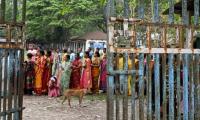ISLAMABAD: Recommending the engagement of market associations in implementing COVID-19 guidelines and standard operating procedures (SOPs), Minister for Planning, Development and Special Initiatives Asad Umer called for strict implementation of ‘no mask, no service’ policy by shopkeepers here on Sunday — a day marked by 88 coronavirus-related deaths and 3,039 new confirmed cases.
Chairing a meeting at the National Command and Operation Centre (NCOC), Asad Umer directed the NCOC to concentrate on easing the lockdown while simultaneously ensuring strict enforcement of SOPs.
The forum suggested strict punitive action on violation of SOPs as the NCOC works to devise a long and short term ‘Living with the Pandemic’ strategy onCOVID-19. Asad called for pursuance of a mass awareness campaign to highlight the measures taken by the government to contain COVID-19 and underscore its achievements.
“The campaign should focus on ensuring behaviour change of people regarding COVID-19 while underlining that the government’s intent to provide safeguards against the pandemic,” he reportedly stated.
Expressing satisfaction over the availability of ventilators in hospitals across Pakistan, Asad called for provision of latest information about availability of beds and other related facilities for information of patients.
The forum was told that the Resource Management System (RMS) would be rolled out across the country with effect from June 1. This system will provide real-time data on availability of resources, facilities, beds, PPEs, ventilators, and other assets in hospitals located all over the country.
The PM’s Special Assistant on Health Dr. Zafar Mirza said the Ministry of Health was planning to mobilise retired doctors of public sector hospitals, young doctors, doctors on house jobs, and final year medical students to cope with the situation. Moreover, new doctors and paramedics would be recruited through walk-in interviews.
The NCOC has asked the provinces to prioritise community mobilisation and set up call centres in their respective areas by June 15.
The forum was informed that the Sindh and Balochistan governments were more inclined towards home quarantine instead of the smart lockdown policy.
The meeting was attended by Interior Minister Syed Ijaz Ahmed Shah, Minister for National Food Security and Research Fakhar Imam, Minister for Economic Affairs Makhdoom Khusro Bakhtiar, Special Assistant to the Prime Minister on National Security Dr. Moeed Yousaf and Dr. Zafar Mirza.
Meanwhile, the National Coordination Committee (NCC) will meet in Islamabad on Monday (today) with Prime Minister Imran in the chair to review the COVID-19 situation and decide whether to ease or further toughen the lockdown to control the increasing number of confirmed cases and fatalities.
According to sources, the committee was slated to meet on Sunday but it was rescheduled and now it would be held at 4:30pm on Monday. The NCC meeting would be attended by the federal ministers, all the four chief ministers, NDMA chief and the federal and provincial health ministries’ officials.
On this occasion, a report would also be tabled detailing the number of corona patients under treatment at various health facilities countrywide. Meanwhile, in a televised briefing, Dr. Zafar Mirza claimed an increase in the number of daily tests after temporary slackening during the Eid holidays.
“With 15,000 tests conducted in the last 24 hours, the total number of tests in Pakistan so far has touched 550,000,” he stated. Dr. Zafar reported an alarmingly high 20% positivity rate among the 15,000 tests performed in a day. The epidemic, he said, is largely driven by local transmission.
“There are 42,742 active coronavirus cases in Pakistan thus far; of these, 4,480 patients are admitted to hospitals, and 723 are in critical condition. Of the 723 critical patients, 201 are on the ventilator — which is the maximum number of patients requiring artificial respiratory support in a day. Majority of the critical care patients require oxygen, not ventilators,” Dr. Zafar stated. He also confirmed 88 deaths in a day — the maximum thus far.
He said the number of confirmed cases had risen to 70,901, with Sindh reporting 28,245 cases, Punjab 25,056, Khyber Pakhtunkhwa 10,027, Balochistan 4,193, Islamabad Capital Territory 2,418,
Gilgit-Baltistan 711, and AJK 251. The death toll has risen to 1,520 with 473 in Khyber Pakhtunkhwa, 475 in Punjab, 481 in Sindh, 47 in Balochistan, 11 in Gilgit-Baltistan, 27 in Islamabad Capital Territory and six in Azad Jammu and Kashmir (AJK).
The SAPM dismissed rumors about Pakistan’s healthcare system bursting at the seams. “There is no such emergency, as acute shortage of beds and ventilators. Only 28% of the total ventilators exclusively dedicated for Covid-19 patients are currently engaged,” Dr. Zafar said, adding there may be occasions of increased pressure in big hospitals located in major cities but the situation is under control.
Speaking on the occasion, National Information Technology Board CEO Shabahat Ali shared details of the NCOC-devised Resource Management System (RMS), which will dispel needless anxiety about availability of beds, ventilators, and hospital-based facilities for COVID-19 patients.
Shabahat said for the last two months, the NCOC had been working to create a consolidated system at the federal level for unified portrayal of data reflecting the location of hospitals across the country’s rural, metropolitan and far-flung areas, along with details of the number of available beds, vents, PPEs, and other assets acquired over a period of time to assist COVID-19 patients in Pakistan.
Reflecting on how the RMS architecture was developed, Shabahat said a list of hospitals in all provinces was developed, the owners of these hospitals were defined, and login IDs and passwords were assigned to them, leading to the development of the system on a centralized console.
“All provinces have access to the centralized data entry system, wherein they directly fed data of all hospitals,” he said.
Terming it a short-term solution, he said the long-term intent was to link up all individual systems in the provinces with the centralized database, so that the centralized system would automatically be updated as and when the provincial systems of hospitals were updated.
“The basic objective was to sync the centralized system with the provincial systems to rule out any discrepancies,” he explained.
“We have plotted all data on a single console map, making it convenient for users to determine the exact number of hospitals and facilities available within a given radius. For instance, if you click at PIMS, you will find that it has 1,255 beds, of which 75 have been reserved for COVID-19 patients. Of these, 31 beds are currently occupied, which means that PIMS still has close to 50% capacity via-a-vis COVID-19 beds,” Shabahat explained.
To introduce an element of mobility in the application, the NITB has made a National Emergency Response App, which can be used by emergency response providers such as 1122, Edhi Foundation, etc.
This application will enable emergency responders to determine the exact location of the nearest available hospital, bed, or vent for a Covid-19 patient that may have come across on the street, and to navigate them to the closest facility to be able to leverage the required service.
All hospitals reflected on the console have been colour-coded; green hospitals have adequate beds and vents; red hospital have vents and beds on full capacity; and yellow hospitals have limited capacity vis-à-vis beds and vents.
The application also provides details about location of laboratories offering Covid-19 testing facilities.
“We are improving the system and would like you to suggest further improvements,” Shabahat advised the public, adding, “We are monitoring the App, and will eventually grant its access to all those who can make use of it at the street level.” Shabahat thanked the administrations of all provinces and areas — starting from Gilgit-Baltistan to Sindh — for sharing their respective systems with the NITB for consolidation.
In Punjab, death toll rose to 475 in Punjab death after 36 more patients on Sunday, while confirmed cases of novel coronavirus raced to 25,056 with the addition of 952 new infections in the province.
So far 188 casualties have been reported from Lahore, 93 in Rawalpindi, 52 Multan, 39 Faisalabad, 34 Gujranwala, 17 Gujrat, nine Sargodha, seven Bahawalpur, six Sialkot, five Rahim Yar Khan, three each in Sheikhupura, Sahiwal, Jhang and Toba Tek Singh, two each in Hafizabad, Muzaffargarh and Narowal and one each in Attock, Dera Ghazi Khan, Bahawalnagar, Nankana Sahib, Kasur, Jhelum and Rajanpur.
Out of 952 new cases of novel coronavirus, 534 were reported in Lahore, 86 Rawalpindi, 63 Faisalabad, 35 Multan, 29 Gujranwala, 20 Bahawalpur, 19 Nankana Sahib, 17 each in Sialkot and Sheikhupura, 15 each in Hafizabad and Rahim Yar Khan, 12 in Toba Tek Singh, 11 each in Bahawalnagar and Sahiwal, eight each in Sargodha and Kasur, seven Khushab, six each in Bhakkar, Okara and Dera Ghazi Khan, five Vehari, four each Jhelum, Attock and Pakpattan, three each Jhang and Layyah and one each in Chakwal, Narowal, Lodhran and Rajanpur.
As per spokesperson for Corona Monitoring Room at Primary and Secondary Healthcare Department, so far 233,685 tests have been performed in the province. Out of these, he said, 25,056 have been tested positive for the virus. He said that highest number of cases have been reported from 16-30 years age group followed by 31-45 years age group. He said that lowest number of cases have been reported from above 75 years age group. He said that 6,901 patients have recovered and sent to their home, 475 died while 17, 680 were isolated at home or under treatment at different quarantine centres and health facilities.
Out of 2,194 healthcare workers screened so far, he said, 344 have been tested positive for the virus.
The situation in Khyber Pakhtunkhwa has become terrible, as coronavirus Sunday claimed 20 lives, two of them senior doctors, the highest number of people dying of the viral infection since its outbreak in the country.
With the latest fatalities, the death toll has risen to 473 — the highest number of human loses in any province. Besides taking 20 lives, the coronavirus infected 487 people, also the highest number of people diagnosed with infection in a single in KP, taking the toll 10027 in the province.
Two senior doctors, including a paediatrician Dr Azam Khan and pathologist Dr Aurangzeb Khan, fell prey to the viral infection. Chief Minister Mahmood Khan expressed shock over the death of the doctors and paid them tribute for services during the Covid-19 pandemic.
Dr Azam was a senior paediatrician and had retired from government service. He belonged to Umarzai area of Charsadda district but since he had served in Nowshera, he settled in Nowshera even after his retirement from government job.
Dr Aurangzeb Khan was posted in the Police Services Hospital, Peshawar that used to receive the first corona patients.
With the loss of these two doctors, KP has so far lost three senior doctors as a result of Covid-19. The fourth doctor dying of coronavirus was an Afghan, Dr Khanzada, but had settled in Hangu.
Of 20 people who died on Sunday, eight of them belonged to Peshawar. Peshawar has suffered more than any other city in country from corona losing 263 people.
Swat has also suffered and lost four people on Sunday. Other districts including Haripur lost two people, and one each died in Lower Dir, Upper Dir, Mardan, Bajaur and Battagram. Swat is second after Peshawar in terms of human losses. It has lost 45 people. Of 473 positive cases, Peshawar recorded 184 cases, taking the toll 3687.
Saad was of the view that the battle of politics should be fought solely through political means
KP govt decided to develop gemstone business as a formal export sector and cluster at the Namak Mandi would be...
Khyber Pakhtunkhwa Minister for Higher Education, Archives, and Libraries, Meena Khan Afridi. — APP FilePESHAWAR:...
Vehicles and horse carts passing through flood water at Bara Bazar area on Khuwani bridge after heavy rain in Peshawar...
Amid the failure to revive the cash-bleeding PIA, government is left with no other option but to sell it to any...
Picture showing the Silver Jubilee Gate of the University of Karachi. — APP File KARACHI: The University of Karachi...







